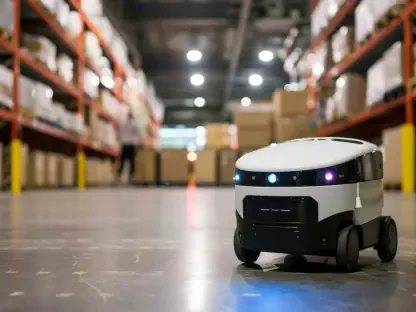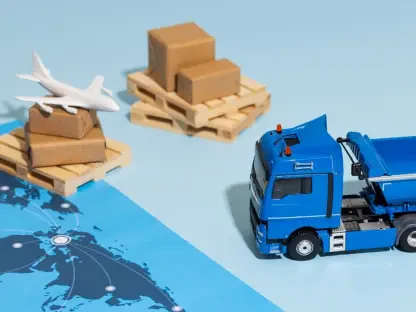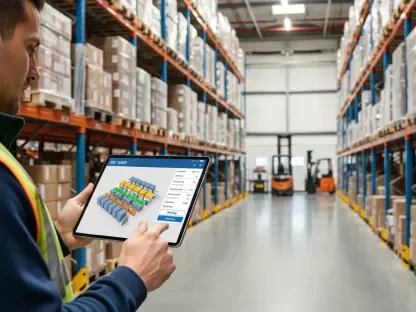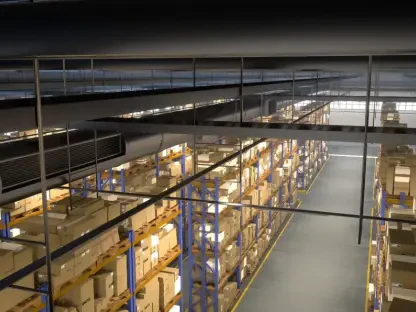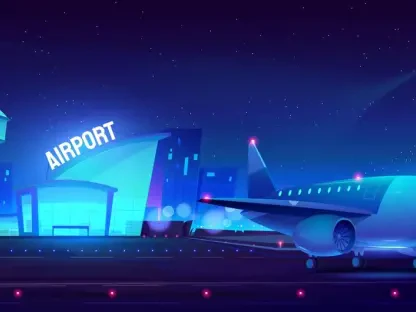Setting the Stage for a Grocery Market Revolution
In an increasingly digital grocery landscape, Kroger, a titan among American supermarket chains, stands at a critical juncture with its recent strategic pivot toward store-based e-commerce fulfillment. With online grocery sales soaring—evidenced by a striking 16% growth in Kroger’s e-commerce revenue in the latest reported quarter—the pressure to balance consumer demand for convenience with operational profitability has never been higher. This shift, aimed at slashing last-mile delivery costs by leveraging the proximity of existing stores, raises pivotal questions about the future of grocery delivery models. How can retailers optimize digital growth without sacrificing financial stability in a hyper-competitive market?
This market analysis delves into the driving forces behind Kroger’s reassessment of its e-commerce strategy, unpacking the trends, data, and projections that shape this transition. It explores the evolving dynamics of grocery delivery, the interplay between automation and store-based solutions, and the broader implications for the retail sector. By examining these elements, the goal is to illuminate the potential impact of this pivot on market competitiveness and consumer expectations, offering a lens into the future of grocery retail efficiency.
Dissecting Market Trends in Grocery E-Commerce
Rising Demand for Digital Grocery Solutions
The grocery sector is witnessing an unprecedented surge in digital adoption, fueled by shifting consumer behaviors toward convenience and speed. Kroger’s latest financial reports highlight this trend, with delivery orders surpassing in-store pickup for the first time, signaling a clear preference for home delivery among shoppers. This uptick reflects a broader industry movement where digital channels are no longer supplementary but central to retail strategies, pushing companies to rethink fulfillment logistics to meet heightened expectations.
Beyond raw numbers, the demand for rapid delivery options has intensified competition among major players. Retailers are compelled to explore cost-effective ways to shorten delivery times while maintaining service quality. Kroger’s focus on utilizing its extensive network of physical stores emerges as a direct response to this challenge, aiming to capitalize on localized inventory to reduce transportation expenses. This trend underscores a critical market reality: proximity to customers is becoming a competitive edge in the race for e-commerce dominance.
Cost Pressures and the Push for Efficiency
Amidst the digital boom, cost pressures loom large over grocery retailers, particularly in the realm of last-mile delivery, which often accounts for a significant portion of e-commerce expenses. Industry data suggests that delivery costs can erode profit margins if not managed strategically, prompting companies like Kroger to reassess capital-intensive investments in standalone automated facilities. The decision to pivot toward store-based fulfillment highlights a growing recognition that existing infrastructure can serve as a cost-efficient fulcrum for online order processing.
This strategic shift also aligns with broader economic realities, such as fluctuating labor costs and inflationary pressures, which necessitate leaner operational models. By integrating online fulfillment into store operations, Kroger aims to minimize overheads associated with new facility construction while still scaling digital services. The market implication here is clear: retailers must balance innovation with fiscal prudence, ensuring that digital expansion does not come at the expense of long-term sustainability.
Analyzing Kroger’s Hybrid Fulfillment Model
Leveraging Store Networks for Last-Mile Gains
A cornerstone of Kroger’s evolving strategy is the utilization of its vast store network as fulfillment hubs, a move designed to optimize last-mile delivery efficiency. With stores already positioned close to customer bases, this approach significantly cuts transportation costs while enabling faster delivery windows—a key differentiator in a market where speed is paramount. The data backs this logic, as Kroger’s e-commerce growth continues to accelerate, driven by consumer demand for localized, immediate service options.
However, integrating online order processing into brick-and-mortar operations presents operational hurdles. Stores must juggle in-person shopping demands with the logistics of picking and packing for delivery, requiring sophisticated inventory management and staff allocation. Despite these challenges, the potential to tap into untapped customer segments through rapid, store-based delivery positions this model as a scalable solution, particularly in diverse regional markets where demand patterns vary widely.
Automation’s Niche in High-Density Zones
While store-based fulfillment takes precedence, Kroger has not entirely sidelined automation, maintaining plans to launch new customer fulfillment centers in high-density areas like Charlotte, North Carolina, and Phoenix within the next couple of years, from 2025 to 2027. These automated facilities, developed in partnership with U.K.-based automation specialists, are tailored for markets with concentrated demand, where high order volumes justify the significant upfront investment. In such regions, robotic warehouses offer unmatched speed and scalability, enhancing customer satisfaction through streamlined processing.
Yet, the uneven performance of automated centers in less populated areas reveals the limitations of a one-size-fits-all approach. Kroger’s ongoing site-by-site evaluation aims to pinpoint where automation yields the strongest returns, suggesting a hybrid model where stores handle smaller or urgent orders while automated hubs manage bulk processing. This selective deployment reflects a maturing market trend: automation must be strategically targeted to avoid overexpansion and financial strain, ensuring resources are aligned with actual demand.
Regional Dynamics Shaping Fulfillment Strategies
Regional disparities play a pivotal role in shaping Kroger’s e-commerce strategy, as urban and rural markets exhibit distinct demand profiles. In densely populated urban centers, automated facilities often outperform due to high order density and rapid customer adoption of delivery services. Conversely, in suburban or rural areas, store-based fulfillment emerges as the more economical choice, leveraging existing infrastructure to serve dispersed populations without the need for costly new builds.
These variations highlight the necessity for a tailored approach, grounded in granular market analysis rather than blanket assumptions. Emerging technologies, such as AI-driven demand forecasting and dynamic routing software, could further bridge these regional gaps by optimizing store-based delivery operations. As the grocery delivery market evolves, Kroger’s ability to adapt its fulfillment mix to local conditions will likely set a benchmark for competitors, illustrating the value of flexibility in addressing diverse consumer needs.
Projecting the Future of Grocery Delivery Markets
Technological Innovations on the Horizon
Looking ahead, the grocery delivery market is poised for transformation through technological advancements that enhance operational efficiency. Innovations like AI for inventory management and last-mile logistics optimization are expected to bolster store-based fulfillment, enabling retailers to predict demand more accurately and reduce delivery bottlenecks. Such tools could redefine how companies like Kroger scale their digital offerings, ensuring seamless integration of online and offline channels.
Additionally, sustainability concerns are likely to influence future market dynamics, with potential investments in electric delivery fleets or partnerships with third-party logistics providers to lower carbon footprints. Regulatory shifts, such as stricter environmental standards for delivery operations, may also shape strategic priorities. The trajectory suggests that retailers embracing tech-driven, eco-conscious solutions will gain a competitive edge, aligning with evolving consumer values while maintaining cost control.
Evolving Consumer Expectations and Market Competition
Consumer expectations for grocery delivery are set to intensify, with demand for ultra-fast delivery and lower fees driving market competition. Retailers will need to continuously innovate to meet these benchmarks, potentially exploring hybrid models that combine the strengths of store-based and automated fulfillment. Kroger’s current pivot offers a glimpse into this future, where adaptability to shifting preferences—such as personalized delivery options—could become a key differentiator.
Competitive pressures from both traditional grocers and tech-savvy newcomers will further complicate the landscape, pushing companies to refine their value propositions. Projections indicate that market leaders will be those who can deliver convenience without compromising profitability, a balance Kroger seeks to achieve through its strategic reassessment. As digital grocery shopping cements its dominance, the ability to anticipate and respond to consumer trends will define long-term success in this space.
Reflecting on Strategic Pathways Forward
Looking back, the analysis of Kroger’s shift toward store-based e-commerce revealed a nuanced response to the dual challenges of digital growth and cost efficiency in the grocery sector. The examination of market trends, regional dynamics, and technological projections painted a picture of an industry in flux, where adaptability proved paramount. The data-driven pivot to leverage existing store networks while selectively deploying automation in high-density zones underscored a pragmatic approach to profitability.
Moving forward, retailers must consider actionable strategies such as investing in localized fulfillment technologies and conducting detailed market assessments to optimize resource allocation. Exploring partnerships for sustainable delivery solutions also emerges as a vital step to align with environmental expectations. These insights offer a roadmap for navigating the complexities of grocery e-commerce, ensuring that innovation and fiscal responsibility go hand in hand in shaping the market’s next chapter.

